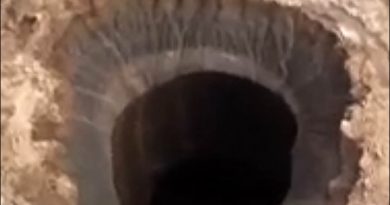Creepy Historical Vampire – The Terrifying Tale of Peter Plogojowitz
Peter Plogojowitz (died 1725) was a Serbian peasant who was believed to have become a vampire after his death and to have killed nine of his fellow villagers. The case was one of the earliest, most sensational and most well documented cases of vampire hysteria. It was described in the report of Imperial Provisor Frombald, an official of the Austrian administration, who witnessed the staking of Plogojowitz.
The case
Peter Plogojowitz lived in a village named Kisilova (possibly the modern Kisiljevo), in the part of Serbia that temporarily passed from Ottoman into Austrian hands after the Treaty of Passarowitz (1718) and was ceded back to the Ottomans with the Treaty of Belgrade (1739) (see Arnold Paole – Background for more details on the historical context). Plogojowitz died in 1725, and his death was followed by a spate of other sudden deaths (after very short maladies, reportedly of about 24 hours each). Within eight days, nine persons perished. On their death-beds, the victims allegedly claimed to have been throttled by Plogojowitz at night. Furthermore, Plogojowitz’s wife stated that he had visited her and asked her for his opanci (shoes); she then moved to another village. In other legends, it is said that Plogojowitz came back to his house demanding food from his son and, when the son refused, Plogojowitz brutally murdered him. The villagers decided to disinter the body and examine it for signs of vampirism, such as growing hair, beard and nails, and the absence of decomposition.
The inhabitants of Kisilova demanded that Kameralprovisor Frombald, along with the local priest, should be present at the procedure as a representative of the administration. Frombald tried to convince them that permission from the Austrian authorities in Belgrade should be sought first. The locals declined because they feared that by the time the permission came, the whole community could be exterminated by the vampire, which they claimed had already happened “in Turkish times” (i.e. when the village was still in the Ottoman-controlled part of Serbia). They demanded that Frombald himself should immediately permit the procedure or else they would abandon the village to save their lives. Frombald was forced to consent.
Together with the Veliko Gradite priest, he viewed the already exhumed body and was astonished to find that the characteristics associated with vampires in local belief were indeed present. The body was undecomposed, the hair and beard were grown, there were “new skin and nails” (while the old ones had peeled away), and blood could be seen in the mouth. After that, the people, who “grew more outraged than distressed”, proceeded to stake the body through the heart, which caused a great amount of “completely fresh” blood to flow through the ears and mouth of the corpse. Finally, the body was burned. Frombald concludes his report on the case with the request that, in case these actions were found to be wrong, he should not be blamed for them, as the villagers were “beside themselves with fear”. The authorities apparently did not consider it necessary to take any measures regarding the incident.
The report on this event was among the first documented testimonies about vampire beliefs in Eastern Europe. It was published by Wienerisches Diarium, a Viennese newspaper, today known as Die Wiener Zeitung. Along with the report of the very similar Arnold Paole case of 1726-1732, it was widely translated West and North, contributing to the vampire craze of the eighteenth century in Germany, France and England. The strange phenomena or appearances that the Austrian officials witnessed are now known to accompany the natural process of the decomposition of the body.
Death
With every indication that he was a vampire, the villagers demanded that steps be taken to prevent his return. The local villagers made a sharp stake and pierced it through Plogojowitz’s heart, forcing blood through his ears and mouth. They then took his dead body and burned it to ashes. Frombald concluded his report by saying if these actions were wrong, that he was not to blame because the local villagers were terrified with fear. This case was the first documented report ever recorded about vampires in Eastern Europe.
Legends
There are legends that say Plogojowitz came back to his house after he was dead and asked his wife for his shoes. His wife handed him his shoes and then quickly left the village of Kisilova for another village. In some other legends, Plogojowitz returned home and demanded food from his son. When his son refused to give him food, he then brutality murdered his own son. This case is similar to another case that occurred in roughly the same time and place: that of Arnold Paole. Both cases occurred in Austria.
The army was called in, and Peters body was exhumed. It was reported that he was breathing and that his open eyes were moving. A stake was put through his heart, resulting in a Tarantino-esque gushing of blood, and his body burned. The deaths and dreams all ended abruptly.
Before their death, each of these villagers complained of exhaustion and appeared to have lost large amounts of blood. If that wasnt suspicious enough, they also all claimed to have dreamed of being visited by Peter. Greatly alarmed by these events, the parish priest wrote to the local magistrate, who passed on the news to a nearby commander of imperial troops. He, two officers and an executioner arrived shortly after receiving the message and they promptly set to exhuming the corpses of all who had died. What they found in Peters grave shocked everyone – for Peters corpse was perfectly preserved and his mouth was covered in blood.
After the discovery, a stake was pounded into Peters chest, blood gushing everywhere. After this they burned his body to ash on a pyre, they then moved on to the other bodies, the bodies of Peters victims. These were reburied with the normal preventative measures – garlic and whitethorn placed with each corpse in the grave.
The local magistrates were determined to put an end to what was happening before a full-scale vampire hysteria broke out. They contacted a local Army commander who happened to be staying nearby, asking him to investigate. The commander arrived in Kislova, bringing with him two other officers, and proceeded to order the immediate exhumation of the body of Peter Plogojowitz. They actually opened all the graves of those who had died subsequent to the farmer’s death, but paid close attention to the corpse that had been Plogojowitz. They found it almost undecayed and lying as if in a trance. In fact, it even appeared to be breathing almost imperceptibly. To the absolute terror of the examiners, the eyes were wide open, and several of those who observed them swore that they moved a little, following the movements of those around the body. His hair and nails had grown, a number of old wounds were now encased in freshly grown skin, and the joints remained supple and moved easily. The farmer’;s mouth was smeared with fresh blood, and his complexion was extremely florid, as though gorged with the substance. The commander and his assistants concluded that this was indeed the vampire who had been terrorizing the district and they should put an end to it.
In accordance with local custom, a sharp wooden stake was driven into the cadaver’s heart, resulting in great quantities of fresh blood pouring forth from every part of the body. Wood was subsequently gathered and formed into a pyre upon which the corpse was then burned. No evidence of vampirism was found upon any of the other bodies that were exhumed along with Plogojowitz. Their copses were replaced in caskets and reburied. After this the dreams and apparitions ceased, as did the deaths in the village.
Returning to Belgrade, the commander and his officers formally convened again and made a report, concluding that Peter Plogojowitz had indeed been a vampire. It was published by Wienerisches Diarium, a Viennese newspaper, today known as Die Wiener Zeitung. Along with the report of the very similar Arnold Paole case of 1726-1732, it was widely translated West and North, contributing to the vampire craze of the eighteenth century in Germany, France and England. The strange phenomena or appearances that the Austrian officials witnessed are now known to accompany the natural process of the decomposition of the body.
To destroy the body, the traditional stake was used. When it was driven through the “vampire,” plenty of what was believed to be fresh blood issued forth from the body. The body also displayed some “wild signs” of vampirism which were not made clear in the report. After the staking, the body was burned and the village was no longer troubled.To avoid repetition, it should be noted that several of the preceding observations can be explained with the arguments presented in the last case. As for the lack of odor, that could depend on a number of factors. It is not clear during what time of year the incident took place. However, if it were winter, it is hard to imagine someone detecing the scent of an exhumed body amid a crowd of people who lived in a less-sanitary time, and who were probably carrying torches. Finally, the condition of the corpse’s nose should be noted. Because the nose is shaped by cartilage alone, it is easy to imagine what would happen to that shape after a body had bloated.
Because of the military involvement, this was one of the best attested cases of its time, and placed Central and Eastern Europe firmly at the centre of vampire lore. The Imperial Provisor who reported the incident was at first against the idea fo the vampire hunt, but he saw that the people could not be discouraged. So he and the parish priest went to the graveyard. When the body was exhumed, the fist thing they noticed was that it was odor-free. They also noticed that the body was not decomposed and was whole, except for the nose, which had fallen away. Also, Plogojowitz’s skin had fallen away, and new skin was growing. The same was true for his nails. Finally, there was blood flowing from his mouth.
To destroy the body, the traditional stake was used. When it was driven through the “vampire,” plenty of what was believed to be fresh blood issued forth from the body. The body also displayed some “wild signs” of vampirism which were not made clear in the report. After the staking, the body was burned and the village was no longer troubled.
To avoid repetition, it should be noted that several of the preceding observations can be explained with the arguments presented in the last case. As for the lack of odor, that could depend on a number of factors. It is not clear during what time of year the incident took place. However, if it were winter, it is hard to imagine someone detecing the scent of an exhumed body amid a crowd of people who lived in a less-sanitary time, and who were probably carrying torches. Finally, the condition of the corpse’s nose should be noted. Because the nose is shaped by cartilage alone, it is easy to imagine what would happen to that shape after a body had bloated.



